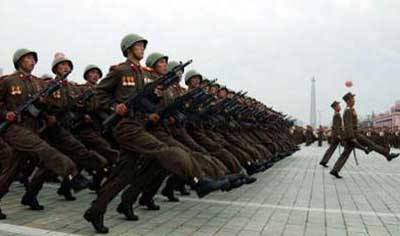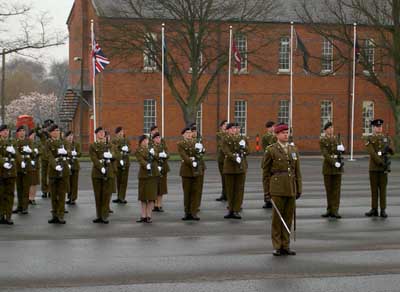Military Drill: Its Theory and Purpose
https://www.vexen.co.uk/military/drill.html
By Vexen Crabtree 2004
1. The History of Drill
Drill is marching. In ancient history, the most powerful, efficient and developed empires developed ways of moving organized units of troops from one place to another on the battlefield, without individuals getting mixed up with other units. Otherwise, as masses of people manoeuvred amongst each other individuals would get lost and end up having to attach themselves to any old unit. A system of flags was developed so people could identify their own units (and side) on the field and make their way to their correct flag bearer if they got separated. But sticking to "formed up" squads was better, forming a box of men who moved as a single body. Overall it meant command systems were effective - men stayed together and could be commanded as units. Josephus, a first century Jewish historian, testifies to the superiority of Roman discipline, and part of that discipline was an ordered method of moving formed up squads from one place to another. This discipline facilitates effective realisation of tactical man-management, and the result is a superior fighting army.1
During what historians have reluctantly come to call "The Military Revolution" European armies between 1550 and 1720 became generally state-controlled, financed and permanent. "There was a resultant loss of individuality, with the need for better organization, good training - especially in drill - and strict discipline"2. Training became an institution.
Since then, drill has become increasingly important as part of training, discipline and military parades. Goose Stepping was a form of extreme marching held by German, Prussian, and Russian heads of military to be an ultimate display of the unbreakable will and discipline of its soldiers. Most modern marching is not as extreme as the rigid goose step. Anything that resembles it is now unpopular because it has become associated with fascism. Nevertheless it is still used by some countries as a powerful display of military discipline.
Military Drill in the Army is formalized with utmost precision in the fearsomely bulky Drill Book. The preamble to the Drill Book states that drill is the foundation of battle discipline. Drill master and anthropologist Robert Graves says there are three types of troops: (1) "those that had guts were no good at drill"; (2) "those that were good at drill but had no guts" and (3) "those that had guys and were good at drill". These last, for some reason or other, fought by far the best"3.
2. Drill and Politics
An army that regularly parades in public displays itself as a highly professional army. Even though the parade itself does not perform any useful function on a battlefield, it has an affect even in times of peace and in build-ups to wars. A rag-tag army is likely to be unable to put on parades, hence it holds that larger and better armies can display their discipline by means of public performances. It therefore acts as a psychological tool and a deterrent - it says that the army is ready, strong and trained.

For example North Korea was facing off against the USA in 2002/2003 and making politically aggressive claims that it was developing nuclear weaponry. It put on a large number of military parades, sometimes including squads of children playing instruments and performing rigid dances, and they received attention in the news, commenting on how "modern" their army and military was. They could clearly be seen to be skilled; and this would act as a deterrent against many lesser armies.
German Nazi parades in the 1930s were awesome, fast and hard. They clearly formed part of the psychological manipulation tools of the Nazis, making the people feel strong and proud, making them happier to put themselves behind such a dedicated and inspiring home force.
So merely as a deterrent and as home inspiration, drill and parades perform useful military and political functions. As we are concentrating, in this text, on the ontology of training procedures, I will now concentrate on the role of drill on the personal development of soldiers physically and mentally, and not look at the role of drill in formal military displays.
3. Drill and Physical Training
 Not everyone has the control over their bodies that athletes have. Strain, stress, laziness, inability, mental weakness and disfamiliarity prevent most people from having maximum control of their own bodies. When situations become stressful, cold or uncomfortable then people who have been trained to rigidly form their bodies around their will can undoubtedly perform better than those people whose only mind-body training has been computer games and casual sport.
Not everyone has the control over their bodies that athletes have. Strain, stress, laziness, inability, mental weakness and disfamiliarity prevent most people from having maximum control of their own bodies. When situations become stressful, cold or uncomfortable then people who have been trained to rigidly form their bodies around their will can undoubtedly perform better than those people whose only mind-body training has been computer games and casual sport.
A recruit will spent an apparent eternity stood motionless at attention, sometimes in seemingly unbearable cold or heat. But with each such session, the cold becomes a little more bearable, the motionlessness becomes more familiar and more elegant and the recruit's body learns a little better how to conform completely to the wishes of its operator.
In a tactical situation, on sentry, you must remain completely quiet and motionless in order to minimize the chances of being seen or heard. A recruit who has mastered hundreds of hours of drill, in the cold and in uncomfortable positions, will also be a master of his own body in such tactical situations.
When a recruit moves on to skill at arms training the casual motionless and calmness, despite discomfort, is an essential ability of a good shot. If a recruit is not used to ignoring the minor discomforts of a held position, their minds will be distracted and their firing will be less accurate.
Once drill is internalized and your body is accustomed to the discipline, it becomes more like a relaxing meditation than hard work, and your mind can wonder. Retrospectively, it feels to some like they no longer find it hard... it is hard, but, they have become accustomed to the hardness.
“If a wise man hold his body with its three parts (chest, neck, and head) erect, and turn his senses with the mind towards the heart, he will then in the boat of Brahman cross all the torrents which cause fear.”
Cvet. Upanisad, ii. 8-13
In "Zen - The Religion of the Samurai" by Kaiten Nukariya (1913)4
4. Drill and Discipline5
Many civilians and military folk like to consider discipline to be the primary role of drill. Parades, it is frequently said, are a display of discipline and in training it forms a method of instilling discipline that can be visually and physically tested. It is a widely recognize method by which you break the will of untrained civilians so that they obey orders in situations where there is no time for a debate, doubt or delay. Yes, discipline is a major part of drill but I hope that by highlighting the other roles it plays before getting on to this subject, I have also highlighted the other functions that drill serves.
When training recruits in drill it tends to bring out peoples' attitudes. Employing typical low-level popular psychology, it is used to "drill" discipline into recruits by pummelling them harder the more they resist, until they "break". When they break, they accept that they're rubbish at drill, that they are making mistakes, and that they will have to keep doing it until they get as good as they are being trained to be. Until they reach that point of breaking, recruits will resist the training. They may think they're "good enough", they may reject the need to do drill or they may reject the commands or make fun of drill. Once broken, they will accept drill. Although previous "attitudes" will surface, they won't interfere anymore with the actual obedience to the commands given. In short, their attitude has been overridden by freshly instilled discipline. That's how drill is seen to instil discipline amongst the average person.
In addition, drill is used within the armed forces as a punishment. Drill can be made very physically demanding. On the coldest days, a squad commander can drill a group of men until they sweat, their legs and feet ache and hurt, and they can no longer perform the moves with full gusto. It is a form of exercise. Keeping those knees waist high when "marking time" (marching on the spot) can be a form of mild torture: a dynamic stress position. As such, many of the low-rankers in the armed faces pretty much hate drill for the memories of the angst. Although some come to like and respect it because they feel the benefits both physically and mentally.